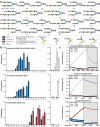This is a preprint.
Receptor Binding Specificity of a Bovine A(H5N1) Influenza Virus
- PMID: 39131339
- PMCID: PMC11312569
- DOI: 10.1101/2024.07.30.605893
Receptor Binding Specificity of a Bovine A(H5N1) Influenza Virus
Update in
-
Receptor-binding specificity of a bovine influenza A virus.Nature. 2025 Apr;640(8059):E21-E27. doi: 10.1038/s41586-025-08822-5. Epub 2025 Apr 16. Nature. 2025. PMID: 40240861 No abstract available.
Abstract
Outbreaks in the US of highly pathogenic avian influenza virus (H5N1) in dairy cows have been occurring for months creating new possibilities for direct contact between the virus and humans. Eisfeld et al. examined the pathogenicity and transmissibility of a bovine HPAI H5N1 virus isolated from New Mexico in a series of in vitro and in vivo assays. They found the virus has a dual human- and avian virus-like receptor-binding specificity as measured in a solid phase glycan binding assay. Here, we examined the receptor specificity of a bovine HPAI H5N1 virus (A/bovine/OH/B24OSU-432/2024, H5N1, clade 2.3.4.4b) employing four different assays including glycan array technology, bio-layer interferometry (BLI), a solid phase capture assay and hemagglutination of glycan remodeled erythrocytes. As controls, well characterized avian (A/Vietnam/1203/2004, H5N1, clade 1) and human (A/CA/04/2009, H1N1) IAVs were included that bind α2,3- and α2,6-sialosides, respectively. We found that A/bovine/OH/B24OSU-432/2024 preferentially binds to "avian type" receptors (α2,3-sialosides). Furthermore, sequence alignments showed that A/bovine has maintained amino acids in its HA associated with α2,3-sialoside (avian) receptor specificity. We conclude that while we find no evidence that A/bovine has acquired human virus receptor binding specificity, ongoing efforts must be placed on monitoring for this trait.
Conflict of interest statement
Competing interests: The authors declare no competing interest for this study.
Figures

References
-
- Xie R. et al. The episodic resurgence of highly pathogenic avian influenza H5 virus. Nature 622, 810–817 (2023). - PubMed
-
- USDA Animal and Plant Health Inspection Service, U. S. Department of Agriculture. HPAI Confirmed cases in livestock herds. https://www.aphis.usda.gov/livestock-poultry-disease/avian/avian-influen....
Publication types
Grants and funding
LinkOut - more resources
Full Text Sources
Research Materials
